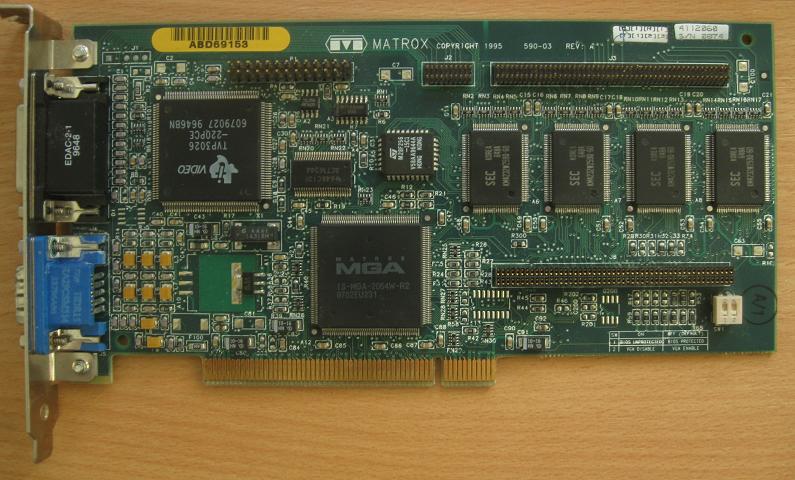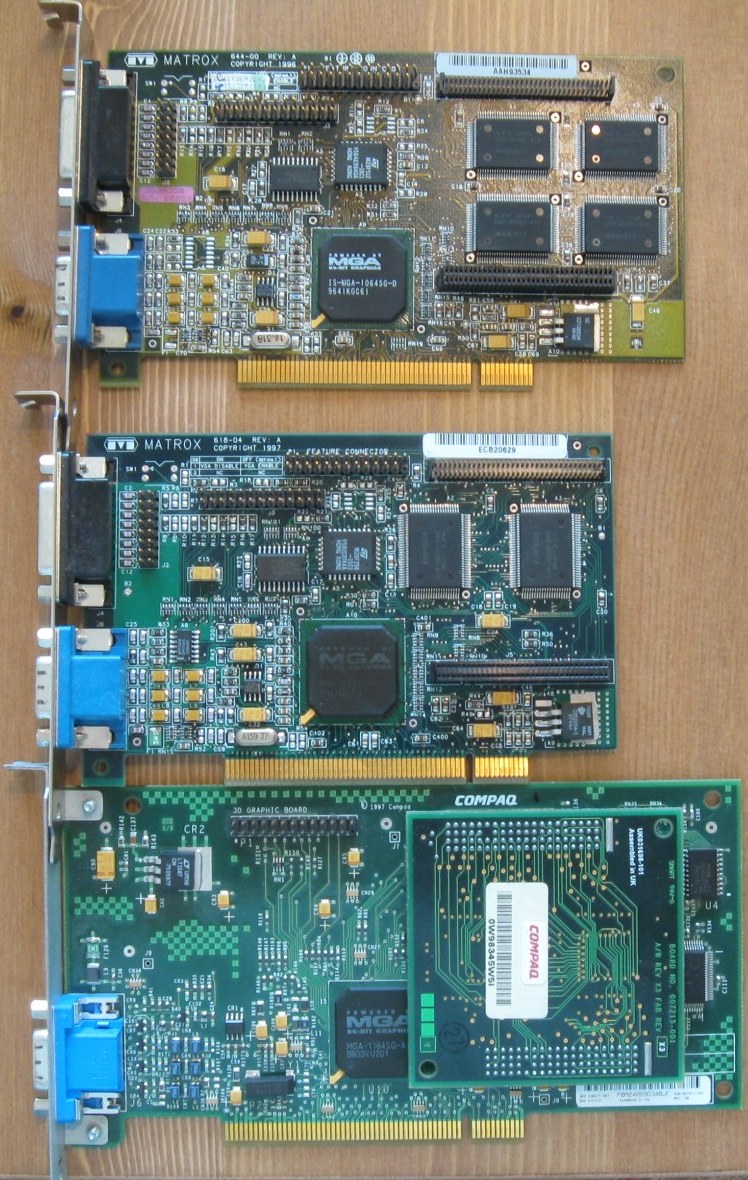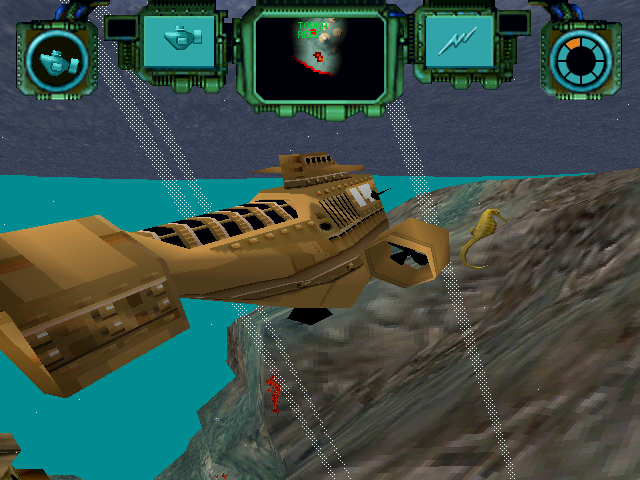Matrox Mystique
Let me skip some of the long history of the company and start with the inception of MGA- 64 bit Matrox Graphics architecture. In the beginning of the nineties the mission was to bring workstation class performance to a PC. First MGA chip Atlas supported high resolution true color 2d accelerator for a new generation of operating systems with demanding graphical user interfaces. In 1993 came Titan chip with feature set expanded by basic 3d operations: Gouraud shading and Z-comparisons. Next chip in the line was Athena, powering the first Impression boards. Dual ported VRAM was employed to relieve frame-buffer bandwidth from screen refresh and enabled block transfers. Z-buffer with 16 bit bus was optional. In the late 1994 Matrox released Impression Plus board, able to theoretically render 150k Gouraud shaded polygons per second. These theoretical numbers are as usual far from gaming reality. Few titles from bundle of gaming edition had around 1000 polygon scenes. High price, weak DOS performance and very limited 3d functionality ensured little popularity of Impression. In 1995 Matrox gave birth to a legend of Windows GUI acceleration- the first Millennium. It was blazing fast 2D card with crisp output for modern graphical interfaces like just fresh Windows 95. The company got into gamers mind despite price premium. Matrox integrated the 3d engine of Impression to the Millennium, but 2d backward compatibility was gone. Thanks to WRAM memory from Samsung the Millenium could stand even against Imagine 128 despite being "only" 64 bit. 3D game developers were not excited about boards without texture mapping, so the gaming support to my knowledge grow beyond the bundled games only through Renderware API support. Millennium's engine is exposed to Direct3d, but I don't know any titles except Turok which would not require texturing.
 First Millennium is specified as 50 MHz but 60 is a more common clock.
First Millennium is specified as 50 MHz but 60 is a more common clock.
The real fight for 3d gamer begun with Mystique in 1996 and Matrox kept on releasing newer versions until summer 1997. The well known difference between early vanilla Mystiques with 170 MHz and later ones with 220 MHz RAMDAC is not the end of it. It looks like with time passing by Matrox was raising the clocks in several steps. The known variants of Mystique "170" are 50/75, 55/82,5 and 60/90 MHz. Mystique 220 had two choices of 60/90 and 66/99 MHz. That is up to 20% undisclosed clock variation among the boards, chip revisions do not correlate with it. It is not nice to keep customers in the dark around such matters. Mystique has DAC integrated to the core and plain synchronous memory interface to reduce board complexity and costs much below expensive Millennium. Now for the cards.
Up here is old Mystique with 1064SG-D chip with slowest clock 50/75 MHz and 4 MB of RAM.
 In the middle is Mystique with 1064SG-H chip and below last 1164SG-A revision.
Both of those Mystiques have system PLL clock of 198, which means they are the top speed models with frequency of 66/99 MHz. Both have 2 MB of 10 ns SGRAM but different form of memory expansion modules. I have only the Compaq type for 1164 board, so this one is used for testing. Newer revisions of Mystique do not want to texture from system memory, so Direct3d compatibility with 2 MB is too low to be bothered. Games written for proprietary API MSI should not have a problem with 2 MB of memory, sometimes lower resolution than 640x480 is needed though. I did run full suite on the slowest board, but there are no surprises. Average framerate difference corresponds to clock difference, how about difference in Final Reality:
In the middle is Mystique with 1064SG-H chip and below last 1164SG-A revision.
Both of those Mystiques have system PLL clock of 198, which means they are the top speed models with frequency of 66/99 MHz. Both have 2 MB of 10 ns SGRAM but different form of memory expansion modules. I have only the Compaq type for 1164 board, so this one is used for testing. Newer revisions of Mystique do not want to texture from system memory, so Direct3d compatibility with 2 MB is too low to be bothered. Games written for proprietary API MSI should not have a problem with 2 MB of memory, sometimes lower resolution than 640x480 is needed though. I did run full suite on the slowest board, but there are no surprises. Average framerate difference corresponds to clock difference, how about difference in Final Reality:

Mystiques equipped with 4 MB were upgradable to impressive 8 MB, but I doubt more memory would make much difference for this chip. Last driver came out in September 1998.
Architecture
Mystique is powered by 1064SG chip, evolving from Millennium's 2064W. PCI interface was enriched by bus mastering. Besides the ramdac Mystique also integrates video engine with hardware scaler. Two main blocks of MGA are Address Processing Unit and Data Processing Unit. APU generates sequences and memory addresses for the DPU. DPU traditionally contains boolean ALU, hardwired color operations and memory interface. Older 3d chips of Matrox had separate unit for shading and depth interpolation, but in Mystique these are now part of the DPU. In more generic terms the DPU is a bare pixel pipeline. The big news of Mystique is texturing unit. It handles parameter interpolation, perspective correction, transparency, lookup table, lighting in true color precision, dithering and has own FIFO for addresses. Memory controller is in charge of depth comparison. Only SDRAM and SGRAM memory up to 8 MB are supported. Integrated DAC features 256x8 dual ported RAM for color lookup table.
Gaming experience
Unfortunately Mystique port of Tomb Raider does not allow FPS counter, so just in few words. It runs fast at 640x480, but I feel slowdowns in complex scenes. Lack of bilinear filtering does not hurt this game much. But most of Direct3d games could use it, especially big low resolution textures like skies looks horrible unfiltered. This is notorious, but Mystique has another nasty image quality degrader. Instead of proper calculations Mystique like to emulate shadows, smokes, environmental maps and similar effects through a crude check board pattern of fully opaque/transparent pixels. This so called stipple alpha was Matrox's choice until G200, worst implementation of alpha blending imaginable. I found this just as annoying as lack of texture filtering. Limited feature set prevents quite a few games from working properly or at all on the Mystique. F22: TAW, Myth 2, Populous:TB, TNP and Thief refuse the board. Some textures in Incoming are missing like if 4 MB of 1164 chip is not enough. This does not happen to old chip, so I may have come to some actual difference between the revisions. There are few games were old 1064 with slower clocks beats fast 1164 and likely ability to texture from system memory is the reason. No Mystique can display textures in Shogo and 3dmark 99. Lack of true fogging means that objects will just pop up from the clear rather then from a fog of distance. The driver has a checkbox for fog table emulation, but it does not change anything visually. It probably just fakes the feature so that games demanding it will run. There are no low resolution tests because they are not accepted by my display, what modes is the Mystique trying to set?
 The killer combo of lack of fogging, filtering and proper blending
View Matrox screenshot gallery
The killer combo of lack of fogging, filtering and proper blending
View Matrox screenshot galleryIncidentally OpenGL games can give a hint of Matrox'es Simple Interface, because Techland wrote a driver based on MSI library for their game using Quake 3 engine. Quake games look just as bad like d3d titles, for all the hardware limitations. In first Quake lightmaps are not even blended with world textures. The framerate is not any higher than d3d wrappers anyway. Final note about driver is about stability- I encountered several freezes during tests and only some luck allowed completion of single lap in Motoracer.
Overclocking
With early Matrox 3d cards things are not so simple if you are looking for maximum. Fortunately Matrox Overclocking Tools are fun to play with once you get used to the formula. First decision is if to leave default 2:3 core/memory ratio or lower memory multiplier to 1:1 ratio in case it severely limits core overclocking. With both of my boards I did not find memory clock to be very limiting. With 1064SG-H board I found maximum clocks at 80/120 hitting memory limits. But strange things happened with 1164SG, after 235 base clock the benchmark results were not improving anymore, like if the board denied to be clocked higher. This means the final clock of 78/117 MHz, only 18 percent gain. However, these Matrox cards are also sensitive to memory timings and SGRAM optimization gives a healthy boost. With my Mystique 220 1164 used for testing I could set the tightest timings even at top clocks: CAS Latency 2, RAS-to-CAS Delay 2 and RAS Minimum Active Time 4. Playing with refresh timer did not make any difference to me.


10% improvement in average frames per second. Minimum FPS increased by 17% percent, almost perfectly in line with clock difference, but don't forget the memory tweaks.
Conclusion
Mystique has its strong and weak sides. Unlike Millennium these boards had friendly pricing and still good GUI performance as one would expect from Matrox. 3d speed is there as well, but in many games one would like to sacrifice some of it for bilinear filtering. The alpha blending patterns are visually poising many games as well. Overall feel is closer to console like Playstation rather than other PC 3d graphics. Mystique's image quality became quickly inadequate and perhaps from there comes the bad nick "Matrox Mistake". Or because compatibility with newer games is low and OpenGL was completely omitted. From a business point of view it did its job well. With 4 millions 3d controllers sold in 1996, Matrox was standing strong with around a quarter of the market.
continue to Millennium 2 review